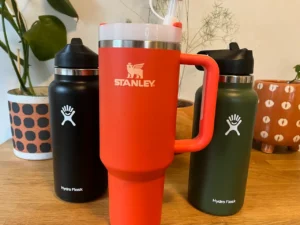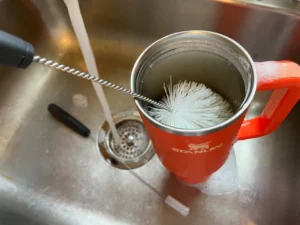Stanley Cups are a super easy and convenient way to stay hydrated and have an ice cold drink handy whenever you want it. But according to some, Stanley Cups are really only safe to drink water from.
So is it actually true that soda and other carbonated drinks in a Stanley Cup are a no-go?
It’s perfectly safe to put soda and other carbonated drinks in your Stanley Cup. The acids found in soda are incredibly unlikely to cause your Stanley Cup’s interior walls to corrode or release harmful compounds through normal use. And because Stanley Cups aren’t airtight, you don’t have to worry about pressure build-up in your tumbler as your drink releases carbon dioxide.
There are a few common reasons people believe you shouldn’t put soda, sparkling water, or any other carbonated beverages in a Stanley Cup — and for the most part, they’re either misguided or just flat out wrong.
Below, I’ll break down each reason and show you exactly why it is or isn’t true.
Will The Acids In Soda Damage Your Stanley Cup?

The most common reason people give for not putting soda in a Stanley Cup is that the phosphoric acid found in some colas may cause the stainless steel inner walls to corrode.
And while it’s true that some sodas are much more acidic than you might expect (Coca Cola is commonly used to remove rust during restoration), short term storage of soda in a Stanley Cup is still completely safe.
Food-grade 18/8 stainless steel is incredibly resistant to corrosion. I’ve yet to see any evidence that the phosphoric or carbonic acids in soda can damage a Stanley Cup.
Can Pressure Build-Up From Carbonation Damage Your Stanley Cup?

Another common theory is that the pressure build-up from putting a carbonated drink in a Stanley Cup could damage your tumbler.
But this one is even further from the truth.
It’s often recommended not to put carbonated drinks in stainless steel bottles because the pressure from the carbonation can build up inside. But that’s only because they’re airtight and all that released gas has nowhere to go.
But Stanley Cups aren’t airtight.
So when your carbonated drink releases carbon dioxide into your Stanley Cup, it just exits your tumbler and harmlessly enters the atmosphere.
And even if your Stanley Cup were airtight, it’s really still no big deal. It just means that your lid may be a little harder to get off because of the internal pressure — but it's not going to explode.
Is Putting Soda In My Stanley Cup Bad For My Health?
And lastly, you may hear that putting carbonated drinks in your Stanley Cup could cause harmful chemicals and metals to leach into your drink.
But in reality, Stanley Cups are completely free of metals that react to acidic drinks, like aluminum, and other potentially harmful materials, like BPA and lead.
This is really only a problem with some cheaper metal tumblers (so make sure your Stanley isn’t a knock-off), because they often cut corners on materials.
It’s not uncommon for low-quality drinkware to contain aluminum (because it’s cheaper to produce than stainless steel) and trace amounts of lead in the seal between their double-walls.
If you’re concerned, sticking to a reputable brand, like Stanley, is your best bet.



